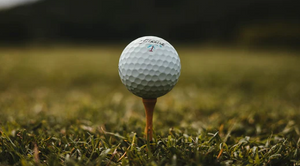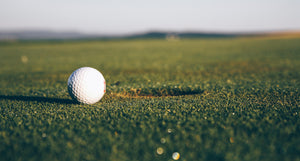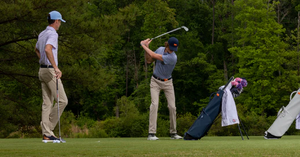Overlap vs. Interlock Golf Grip
Choosing the correct grip can make or break your game. It's true: the grip is the first step in learning a proper swing form.
Without the appropriate grasp, producing consistent golf shots is darn near impossible. A good grip ensures your hands work in unison so that the clubhead meets the ball at a square angle for accurate shots.
The overlap and interlock grip are two of the most popular methods of gripping a golf club. In this guide, we'll explain both methods, covering the benefits and drawbacks of each.
Overlap Golf Grip Explained
An overlapping grip is when the pinky of your bottom hand rests on the groove between your middle and index finger. It's designed to create a secure hold on the club without affecting wrist flexibility.
You’ll want to create a ten-finger hold to form an overlapping grip. Then, lift the pinky finger of your trailing hand and place it between your primary hand's middle and index finger. The leading hand’s thumb should point down towards the club. Also, ensure there isn’t any gap between the hands. Let's go over some benefits!
The Benefits of an Overlapping Golf Grip
There’s a reason why some of the best golfers in the world, like Matt Kuchar and Ben Hogan, use the overlapping grip. Here are the most common benefits of using this style:
Unifies the Hands
The overlapping grip forces you to bind your hands, which allows them to work in unison throughout the swing. As a result, the grip reduces the risk of erratic hand movement. In short, this ensures greater ball accuracy.
Ideal for People with Large Hands
Overlapping your hands provides an additional layer beyond the grip to hold onto, allowing you to feel in control. Thus, many golfers with large hands feel more comfortable with the overlap grip.
Looser Grip
A typical interlocking or ten-finger grip can cause you to grip the club too tightly. This can lead to a closed clubface during impact, negatively impacting power and accuracy. The overlap grip loosens your hold while maintaining control.
Learn to Let Go
A looser grip will allow you to develop more rhythm and flow, showing how little effort it can take to achieve solid contact with the ball.
Follow the Pros
Modeling your swing after professional golfers is an excellent way to improve. Most professionals use the overlapping grip due to all the benefits mentioned above.
The Drawbacks of an Overlapping Golf Grip
While the overlapping grip is widely used by many, it’s certainly not for everyone. Below are a few drawbacks:
Not Ideal for Small Hands
Smaller hands may struggle to gain optimal control with this style. Why? These golfers' fingers may have a harder time making contact with each other. If you don't have long fingers, the interlocking grip may be for you. More on that in a moment!
Open Face During Impact
A looser grip can disempower some golfers from closing the clubface to get a square impact. Thus, the clubface remains open, which causes you to slice or push your shots.
Interlock Golf Grip Explained
In an interlocking grip, the pinky on your right hand fits between the middle and index finger on your left hand. This grip creates a firm hold on the club, which can provide greater control.
This firm hold means the club rests on the finger’s base, and the handle is well inside the golfer’s palms - designed to create more powerful shots while improving distance accuracy and slice shots.
The Benefits of an Interlocking Golf Grip
Many golfers choose the interlocking grip for its many benefits. Here are a few below.
Ideal for People with Small Hands
The interlocking grip is ideal for golfers with small hands who find it challenging to create a firm grip. Pro golfers like Jack Nicklaus maintain that interlocking grips enable female golfers to improve their grip on the club and reduce excessive wrist movement.
Requires Little Effort
Natural strength plays a role in grip style choice. Jack Nicklaus also believes the interlocking grip best suits golfers with weaker hands. When interlocked fingers wrap around a cushioned grip, the club is locked in place with little effort.
However, an interlocking grip also helps golfers with strong hands to maintain a firm grip without exacerbating tension in their forearms and hands. Relaxed muscles are crucial to developing swing speed, allowing for more control, power, and distance on your shots.
Prevents Hands from Slipping
Have you had your hands fly off the club during a backswing? Slippage typically occurs when players use a ten-finger grip. The interlocking grip ensures the hand stays on the club throughout the golf swing. Ah, peace of mind.
Unity
In an interlocking grip, the pinky finger of the right-hand locks with the forefinger of the left hand. As a result, this forms a connection that pulls the hands together and creates a firm hold.
When swinging your club, the wrists act as a hinge, creating centrality and preventing off-target shots.
The Drawbacks of an Interlocking Golf Grip
Interlocking grip isn’t for everyone. Some disadvantages come with using this grip style, such as:
Too Much Grip Pressure
Applying enough pressure on the club’s grip allows you to generate sufficient power and clubhead speed on the downswing. It also keeps your club on plane to deliver accurate shots.
Casual golfers with excessively tight grips will close the clubface at contact, causing consistent hooks. An overly solid grip can also restrict the wrist hinge, which may cause a beginner to bleed power through their back and downswing.
Discomfort
Besides potential hooks, an interlock grip tends to be uncomfortable, especially for players with larger hands. Because it can feel unnatural for amateur golfers, many get their feet wet with the overlap grip.
Blisters
Playing with an excessively tight interlock grip may lead to cuts and blisters on the webbing between your ring and right pinky finger. The friction and pressure of the glove on this delicate area may prompt blisters. A blister in the webbing of your finger makes playing golf uncomfortable, which affects your ability to practice and improve your game.
What Are the Differences Between an Overlap and an Interlock Grip?
The primary difference between the overlap and interlock grip is the positioning of the pinky finger on the dominant hand. With an overlap grip, the right pinky rests between the middle and index fingers on the top left hand.
Conversely, with an interlocking grip, the right pinky locks between the middle and index fingers, keeping the hands locked together during the golf swing.
This physical difference changes the way the golf club releases. The overlap grip allows for greater flexibility in the wrists and creates a more prominent release of the right hand - ideal for fixing a slice. However, the interlock grip quiets your trail hand and encourages a release with less clubface rotation.
Frequently Asked Questions
Below are the most frequently asked questions about golf grips.
What Is the Baseball Golf Grip?
The baseball grip requires all ten fingers to contact the golf clubs. This grip maximizes leverage from the arms to for even more power and distance. Many beginners choose the baseball golf grip for its comfort and ease.
Which Golf Grip Do Most Pro Golfers Use?
Pro golfers like Phil Mickelson, Ben Hogan, and Arnold Palmer use the overlap grip. Pro golfers tend to have larger hands, capable of swinging clubs at high speeds. This grip then allows for optimal hand placement without swinging the club too hard.
Final Thoughts
The grip you choose impacts the point of impact and your swing path. A weak grip can cause a nasty slice, while a strong one can cause you to hook your shots. The key is to find a balance between the two for proper accuracy, distance, and power.
Trial and effort is the best way to know which grip will work best for you. We recommend finding a comfortable grip that provides wrist flexibility and unity throughout your swing.
If you want to level up your game, having the best golf gear can significantly help you on the course. Shop for quality golf bags and apparel from Stitch Golf. Once you’ve got the perfect setup, it’s time to head to your local club and hit some balls!



